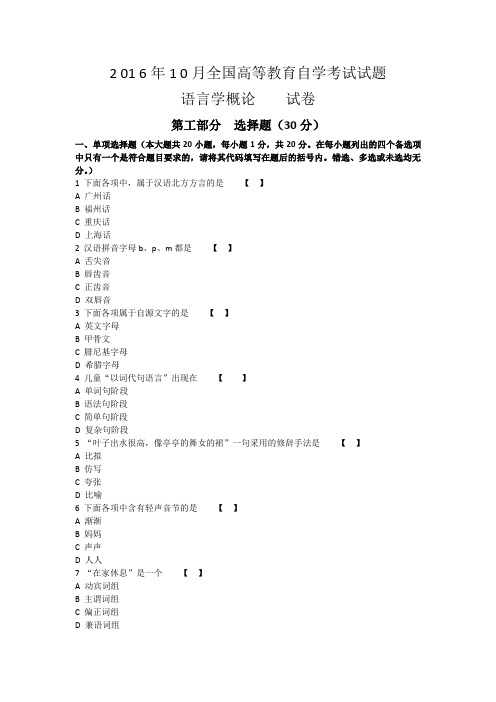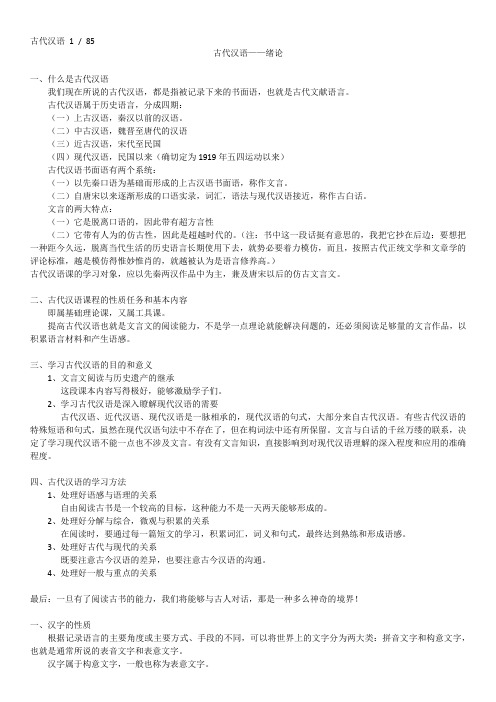00536 古代汉语真题 自学考试2016年10月
2016年4月自考《古代汉语》00536真题及答案

2016年4月自考《古代汉语》真题及答案课程代码00536单项选择题:本大题共20小题,每小题l分,共20分。
在每小题列出的备选项中只有一项是最符合题目要求的,请将其代码填写在题后的括号内。
错选、多选或未选均不得分。
1、汉字笔画的最后定型,是在()A.汉隶阶段B.楷书阶段C.古隶阶段D.行书阶段正确答案:B2、许慎所举“考、老”两字,用来说明的“六书”中的定义是()A.本無其字,依聲託事B.畫成其物,隨體詰詘C.建類一首,同意相受D.以事爲名,取譬相成正确答案:C3、下列对汉字结构的分析完全正确的一项是()A.泅,从水从囚。
会意B.眉,从目上长眉毛。
会意C.吹,从口从欠。
会意D.餓,从我从食。
会意正确答案:C4、下列各组字中,象形、指事、会意、形声都具备的一组是()A.大舂栗項B.本賴雷高C.祭題血莫D.夜亦向息正确答案:D5、下列句中,加着重号的字与括号内的字是假借关系的一句是()A.北<冥>(溟)有魚,其名曰鯤。
B.郢人堊<慢>(漫)其鼻端,若蠅翼,使匠石斵之。
C.民食果蓏<蜯>(蚌)蛤。
D.食桃而甘,不盡,以其半<啗>(啖)君。
正确答案:B6、下列4组字原来都是异体字关系,其中一组后来记词职能有了分工,这组字是( )A.咳—孩B.污—汙C.麯—麴D.磊—磥正确答案:A7、下列句中,加着重号的部分属于联绵词的一句是()A.夫山居而谷汲者,(膢臘)而相遺以水。
B.今媼尊長安君之位,而封之以(膏腴)之地。
C.邦分崩(離析)而不能守也,而謀動干戈於邦內。
D.婉貞揮刀奮斫,所當無不(披靡)。
正确答案:D8、下列句中,加着重号的“易”表示“轻视”义的一句是( )A.逢丑父與公(易)位。
B.是以古之(易)財,非仁也,財多也。
C.世(易)時移,變法宜矣。
D.夫然後足以化民(易)俗,近者說服而遠者懷之。
正确答案:B9、下列句中,加着重号的词用本义的一句是()A.今有一人,入人園圃,竊其桃李,衆(聞)則非之。
2016年10月全国高等教育自学考试试题

2 01 6年1 0月全国高等教育自学考试试题语言学概论试卷第工部分选择题(30分)一、单项选择题(本大题共20小题,每小题1分,共20分。
在每小题列出的四个备选项中只有一个是符合题目要求的,请将其代码填写在题后的括号内。
错选、多选或未选均无分。
)1 下面各项中,属于汉语北方方言的是【】A 广州话B 福州话C 重庆话D 上海话2 汉语拼音字母b、p、m都是【】A 舌尖音B 唇齿音C 正齿音D 双唇音3 下面各项属于自源文字的是【】A 英文字母B 甲骨文C 腓尼基字母D 希腊字母4 儿童“以词代句语言”出现在【】A 单词句阶段B 语法句阶段C 简单句阶段D 复杂句阶段5 “叶子出水很高,像亭亭的舞女的裙”一句采用的修辞手法是【】A 比拟B 仿写C 夸张D 比喻6 下面各项中含有轻声音节的是【】A 渐渐B 妈妈C 声声D 人人7 “在家休息”是一个【】A 动宾词组B 主谓词组C 偏正词组D 兼语词组8 不同行业有自己的“行话”,“行话”属于【】A 地域方言B 社会方言C 亲属语言D 混合语言9 “半两棉花——免弹(谈)”采用的方法是【】A 转移双关B 语义双关C 语音双关D 替代双关10 下面备项属于语言符号特点的是【】A 约定性B 自然性C 固定性D 想象性11 一种语言的共同语是在某一个方言的基础上形成的,这种方言叫【】A 母方言B 底层方言C 基础方言D 原始方言12 谈话体属于【】A 书面语体B 宣传语体C 文学语体D 口语语体13 唐太宗名李世民,唐代人便把“世”改为“代”,把“民”改成“人”,这是为了【】A 避讳B 图吉利C 讨口彩D 自谦14 中国历史上推行“书同文”措施的是【】A 齐桓公B 秦始皇C 汉武帝D 唐玄宗15 汉语中“罗汉、菩萨、塔、阎罗”等词的出现,是因为【】A 儒家学说的兴盛B 道教的兴起C 名教的影响D 佛教的传人16 “弟弟吃苹果”不能说成“苹果弟弟吃”,这是受制于语言符号的【】A 组合关系B 聚合关系C 联想关系17 音高取决于声波的【】A 振幅B 数量C 长短D 频率18 “这是革命的春天,这是人民的春天,这是科学的春天”,这个句子是【】A 反复句B 顶真句C 对偶句D 回环句19 中国叫“绥远、定远”之类名字的地方,往往当年【】A 水草丰美B 山川秀丽C 曾发生战乱后被抚平D 人口特别多20 一个民族的全体或部分成员放弃使用本民族语言转而使用另一民族语言的现象叫【】A 语言混合B 语言转用C 克里奥尔D 双语现象二、多项选择题(本大题共5小题,每小题2分,共10分。
高等教育自学考试全国统一大学语文真题2016年10月及答案解析

《西湖七月半》用“如聋如哑”形容“人声鼓吹”,所表示的是______
A.观月者如聋子一样听不到声音
B.门军不允许观月者发出声音
C.观月者的各种声音ቤተ መጻሕፍቲ ባይዱ相掩盖,一片嘈杂
D.声音太大,使观月者都成了哑巴和聋子
上一题下一题
(10/20)单项选择题(本大题共20小题,每小题1分,共20分)
在每小题列出的四个备选项中有一个是符合题目要求的,请净其代码填写在题后的括号内。错选、多选或未选均无分。
第8题
《先妣事略》中,“儿女大者攀衣,小者乳抱,手中纫缀不辍”这一细节所表现的是______
A.母亲持家勤劳
B.母亲对缝纫的喜爱
C.子女依赖母亲
D.家庭多子女的痛苦
上一题下一题
(9/20)单项选择题(本大题共20小题,每小题1分,共20分)
在每小题列出的四个备选项中有一个是符合题目要求的,请净其代码填写在题后的括号内。错选、多选或未选均无分。
A.铁凝
B.余秋雨
C.宗璞
D.史铁生
上一题下一题
(13/20)单项选择题(本大题共20小题,每小题1分,共20分)
在每小题列出的四个备选项中有一个是符合题目要求的,请净其代码填写在题后的括号内。错选、多选或未选均无分。
第13题
《湘夫人》中,湘夫人终究没来,湘君将衣物投入水中,其用意是______
A.抒发绝望悲伤的感受
第7题
《赵武灵王胡服骑射》中,赵武灵王主动去见公子成所体现的治国理念是______
A.国听于君
B.从政先信于贵
C.制国有常
D.明德先论于贱
上一题下一题
(8/20)单项选择题(本大题共20小题,每小题1分,共20分)
全国自考大学语文,考试真题及答案。全国自考《语言学概论》历年真题及答案

大学语文,考试真题。
四、简析题(本大题共5小题,每小题6分,共30分)36.阅读《容忍与自由》中的一段文字,回答问题:我曾说过,我应该用容忍的态度来报答社会对我的容忍。
现在常常想,我们还得戒律自己:我们若想别人容忍谅解我们的见解,我们必须先养成能够容忍谅解别人的见解的度量。
至少至少我们应该戒约自己决不可“以吾辈所主张者为绝对之是”。
我们受过实验主义的训练的人,本来就不承认有“绝对之是”,更不可以“以吾辈所主张者为绝对之是”。
A.这段文字是针对文章中哪一个事例所生发的议论?强调“以吾辈所主张者为绝对之是”的是谁?针对陈独秀提倡白话文的事例。
陈独秀;B.“绝对之是”是什么意思?“不允许反对者有讨论之余地”不能够容忍别人的不同意见。
自己的意见绝对正确。
C.这段文字的论点是什么?该论点对文章中心论点的论述有什么作用?论点:不承认有“绝对之是”。
宇宙无限,人的认识有限。
是总论点“没有容忍,就没有自由”的三个分论点之一。
37.阅读《哭小弟》中的一段文字,回答问题:我哭小弟,哭他在剧痛中还拿着那本航空资料“想再看看”,哭他的“胃下垂”、“肾游走”;我也哭蒋筑英抱病奔波,客殇成都;我也哭罗健夫不肯一个人坐一辆汽车!我还要哭那些没有见诸报章的过早离去的我的同辈人。
他们几经雪欺霜冻,好不容易奋斗着张开几片花瓣,尚未盛开,就骤然凋谢。
我哭我们这迟开而早谢的一代人!已经是迟开了,让这些迟开的花朵尽可能延长他们的光彩吧。
A.举例说明文中使用了何种修辞手法。
比喻,排比;B.文中的“雪欺霜冻”和“骤然凋谢”的寓意是什么?政治运动对知识分子的迫害;英年早逝;C.文中揭示主旨的是哪一句话?让这些迟开的花朵尽可能延长他们的光彩吧38.阅读《我与地坛》中的一段文字,回答问题:剩下的就是怎样活的问题了。
这却不是在某一个瞬间就能完全想透的,不是能.够一次性解决的事,怕是活多久就要想它多久了,就像是伴你终生的魔鬼或恋人。
所以,十五年了,我还是总得到那古园里去,去它的老树下或荒草边或颓墙旁,去默坐,去呆想,去推开耳边的嘈杂理一理纷乱的思绪,去窥看自己的心魂。
古代汉语 自考00536

古代汉语——绪论一、什么是古代汉语我们现在所说的古代汉语,都是指被记录下来的书面语,也就是古代文献语言。
古代汉语属于历史语言,分成四期:(一)上古汉语,秦汉以前的汉语。
(二)中古汉语,魏晋至唐代的汉语(三)近古汉语,宋代至民国(四)现代汉语,民国以来(确切定为1919年五四运动以来)古代汉语书面语有两个系统:(一)以先秦口语为基础而形成的上古汉语书面语,称作文言。
(二)自唐宋以来逐渐形成的口语实录,词汇,语法与现代汉语接近,称作古白话。
文言的两大特点:(一)它是脱离口语的,因此带有超方言性(二)它带有人为的仿古性,因此是超越时代的。
(注:书中这一段话挺有意思的,我把它抄在后边:要想把一种距今久远,脱离当代生活的历史语言长期使用下去,就势必要着力模仿,而且,按照古代正统文学和文章学的评论标准,越是模仿得惟妙惟肖的,就越被认为是语言修养高。
)古代汉语课的学习对象,应以先秦两汉作品中为主,兼及唐宋以后的仿古文言文。
二、古代汉语课程的性质任务和基本内容即属基础理论课,又属工具课。
提高古代汉语也就是文言文的阅读能力,不是学一点理论就能解决问题的,还必须阅读足够量的文言作品,以积累语言材料和产生语感。
三、学习古代汉语的目的和意义1、文言文阅读与历史遗产的继承这段课本内容写得极好,能够激励学子们。
2、学习古代汉语是深入瞭解现代汉语的需要古代汉语、近代汉语、现代汉语是一脉相承的,现代汉语的句式,大部分来自古代汉语。
有些古代汉语的特殊短语和句式,虽然在现代汉语句法中不存在了,但在构词法中还有所保留。
文言与白话的千丝万缕的联系,决定了学习现代汉语不能一点也不涉及文言。
有没有文言知识,直接影响到对现代汉语理解的深入程度和应用的准确程度。
四、古代汉语的学习方法1、处理好语感与语理的关系自由阅读古书是一个较高的目标,这种能力不是一天两天能够形成的。
2、处理好分解与综合,微观与积累的关系在阅读时,要通过每一篇短文的学习,积累词汇,词义和句式,最终达到熟练和形成语感。
高等教育自学考试全国统一大学语文真题2016年10月及答案解析

第11题
下列《纪念傅雷》语句中,体现了文章机趣幽默特点的是______
A.俗话说:“秀才人情纸半张。”我连这半张纸也没有献在老朋友灵前
B.后来知道他的别号就叫“怒庵”,也就不以为奇
C.一九六六年八月下旬,我已经在里弄里被“示众”过了
高等教育自学考试全国统一大学语文真题2016年10月及答案解析
(1/20)单项选择题(本大题共20小题,每小题1分,共20分)
在每小题列出的四个备选项中有一个是符合题目要求的,请净其代码填写在题后的括号内。错选、多选或未选均无分。
第1题
下列《五代史伶官传序》具体论断中,可以全面概括后唐庄宗事迹的是______
A.揭示爱情历程艰难曲折、令人痛苦
B.愿意为爱情献出生命
C.决心为爱情以及更崇高的目标献身
D.不愿为爱情牺牲自由
上一题下一题
(19/20)单项选择题(本大题共20小题,每小题1分,共20分)
在每小题列出的四个备选项中有一个是符合题目要求的,请净其代码填写在题后的括号内。错选、多选或未选均无分。
第19题
A.直抒胸臆
B.借景抒情
C.借举止抒情
D.借象征抒情
上一题下一题
(17/20)单项选择题(本大题共20小题,每小题1分,共20分)
在每小题列出的四个备选项中有一个是符合题目要求的,请净其代码填写在题后的括号内。错选、多选或未选均无分。
第17题
《一句话》的语言特点是______
A.自然平易,节奏鲜明
B.朴实无华,含蓄蕴藉
消:
上一题下一题
(10/10)词语解释(本大题共10小题,每小题1分,共10分)
汉语言文学自考本科专业00538中国古代文学史(一)2016年10月真题及答案
42.(1)有一种意蕴深沉之美。(1 分)
(2)有一种清逸玄远之美。(1 分)
(3)融哲理、情思与意象为一炉,成为正始时代诗歌的高峰,创造了抒情组诗的新形式。(3
分)
43.(1)七言绝句以山水诗和送别诗为多。表现人与自然的融合,表现日常生活中的人情之美,
兴到神会,一挥而就,自然天成。(2 分)
(2)五言绝句以简洁明快的语言,表达无尽的情思,自然含蓄。(2 分)
38.(1)晚唐五代出现的词派,词风婉丽绮靡。(1 分)
(2)代表作品为《花间集》。(1 分)
(3)代表人有温庭筠、韦庄。(1 分)
39.(1)盛唐诗人高适、岑参齐名,世称“高岑”。(2 分)
(2)高适、岑参诗多写边塞生活,为唐代边塞诗派的代表作家。(1 分)
四、简答题(本大题共 4 小题,每小题 5 分,共 20 分)
中国古代文学史试卷第 4 页
共 6页
中国古代文学史(一)201610 参考答案
课程代码(00538)
一、单项选择题(本大题共 20 小题,每小题 1 分,共 20 分)
1.A 2.B 3.C 4.A 5.C 6.A 7.A 8.C 9.C 10.B
11.D 12.C 13.A 14.C 15.D 16.B 17.A 18.B 19.D 20.C
(3)李白绝句受乐府民歌的影响,具有乐府民歌风格。(1 分)
五、论述题(本大题共 2 小题,每小题 14 分,共 28 分)
44.(1)楚辞的产生与楚声、楚歌有直接关系。(2 分)
(2)楚辞的产生与楚国民间“巫歌”关系紧密。(2 分)
(3)楚辞充满楚地风物的描写。(2 分)
(4)楚辞也受到了北方文化的影响。(2 分)
三、名词解释题(本大题共 4 小题,每小题 3 分,共 12 分) 36.《论语》 37.宫体诗 38.花间词派 39.“高岑” 四、简答题(本大题共 4 小题,每小题 5 分,共 20 分)
自考古代汉语试题及答案(精编文档).doc
【最新整理,下载后即可编辑】古代汉语试题及答案第一部分选择题一、单项选择题(本大题共30小题,每小题1分,共30分)在每小题列出的四个选项中只有一个选项是符合题目要求的,请将正确选项前的字母填在题后的括号内。
1.专门解释唐宋元明清之间诗、词、曲中习用的特殊语词的词典《诗词曲语辞汇释》的作者是()A.杨树达B.张相 C.朱起凤 D.符定一2.下面几个字中的省形字是()A.项B.狄 C.娶 D.考3.下面几个部首,可以表示房屋意义的是()A.宀B.厂 C.示 D.邑4.下面几组汉字,全为合体字的一组是()A.奚何来B.戒尖舟 C.出走见 D.即休飞5.古书中的专名“单于”、“可汗”读音全都正确的一组是()A.Dān yú;KěhànB.Chán yú;Kě hànC.Chán yú;KèhánD.Dān yú;Kè hán6.下面几组汉字,全为会意字的一组是()A.森相肉B.屋前臣 C.向陟门 D.美家库7.下面几组字,不属于古今字关系的一组是()A.垂陲B.难谁 C.齐剂 D.赴讣8.下面各句,有形容词用如意动的句子是()A.今先生俨然不远千里而庭教之。
B.楚左尹项伯者,素善留侯张良。
C.强本而节用,则天不能贫。
D.其达士,洁其居,美其服,饱其食。
9.下面各句,有名词用如使动的句子是()A.孔子之作《春秋》也,诸侯用夷礼,则夷之。
B.范增数目项王。
C.今欲并天下……制海内,子元元,臣诸侯,非兵不可。
D.黎丘之鬼效其子之状,扶而道苦之。
10.下面各句,用有表示工具的名词状语的句子是()A.天下支集而响应,赢粮而景从。
B.秦军降诸侯,诸侯吏卒乘胜,多奴虏使之。
C.秦惠王车裂商君以徇。
D.横历天下,廷说诸侯之王。
11.下面各句,“莫”为否定副词的一句是()A.君有急病见于面,莫多饮酒。
自考古代汉语试题及答案
自考古代汉语试题及答案古代汉语试题及答案第一部分选择题一、单项选择题(本大题共 30小题,每小题1分,共30分)在每小题列岀的四个选项中只有一 个选项是符合题目要求的,请将正确选项前的字母填在题后的括号内。
1.专门解释唐宋元明清之间诗、词、曲中习用的特殊语词的词典《诗词曲语辞汇释》的作者是D.符定一2.下面几个字中的省形字是(D.考D.邑D.即休飞5. 古书中的专名“单于”、“可汗”读音全都正确的一组是(B.Ch d n y u; K e h anC.Ch a n y u; K e h an6. 下面几组汉字,全为会意字的一组是(D.美家库7. 下面几组字,不属于古今字关系的一组是A.杨树达B.张相C.朱起A.项B.狄C.3.下面几个部首, 可以表示房屋意义的是A.B.厂C.4.下面几组汉字, 全为合体字的一组是(A.奚何来B.戒尖舟C.出走A.D a n y u; K e h an D.D a n y u; K e h anA.森相肉B.屋前臣C.向陟8. 下面各句,有形容词用如意动的句子是(A. 今先生俨然不远千里而庭教之。
B.楚左尹项伯者,素善留侯张良。
C. 强本而节用,则天不能贫。
D.其达士,洁其居,美其服,饱其食。
9. 下面各句,有名词用如使动的句子是()A. 孔子之作《春秋》也,诸侯用夷礼,则夷之。
B. 范增数目项王。
C. 今欲并天下……制海内,子元元,臣诸侯,非兵不可。
D. 黎丘之鬼效其子之状,扶而道苦之。
10. 下面各句,用有表示工具的名词状语的句子是A. 天下支集而响应,赢粮而景从。
B. 秦军降诸侯,诸侯吏卒乘胜,多奴虏使之。
C. 秦惠王车裂商君以徇。
D. 横历天下,廷说诸侯之王。
11. 下面各句,“莫”为否定副词的一句是(A. 君有急病见于面,莫多饮酒。
C.保民而王,莫之能御也。
12. 下列句中的“是”字,作判断句主语的是(A. 其是之谓乎?也。
C.是?元和四年也。
13. 下面各句,“之”是连词且用于主谓之间的是(A. 百亩之田,勿夺其时,数口之家可以无饥矣。
全国自考《古代汉语》真题及答案
全国自考《古代汉语》真题及答案卷面总分:100分答题时间:80分钟试卷题量:35题一、单选题(共20题,共60分)题目1:下列句子,属于双宾语句的一句是()。
A.止子路宿,杀鸡为黍而食之B.寡君使群臣为鲁卫请C.君子疾夫舍曰欲之而必为之辞。
D.盍各言尔志正确答案:C题目2:下列句子,属于被动句式的一句是()。
A.象有齿以焚其身B.吾闻用夏变夷者,未闻变于夷者也C.空自苦无人之境,信义安所见乎。
D.今不取,后世必为子孙忧正确答案:B题目3:下列句子为判断句的一句是()。
A.知之为知之,不知为不知B.是非君子之言也C.如今人方为刀俎,我为鱼肉D.四体不勤,五谷不分,孰为夫子正确答案:B题目4:下列句中,“于”引进比较对象的一句是()。
A.克于先大夫,无能为役B.卻克伤于矢,流血及屦C.陵与卫律之罪,上通于天D.吾长见笑于大方之家正确答案:D题目5:下列句子,属于名词用作状语表示工具的一句是()。
A.惠等哭,舆归营B.文人相轻,自古而然C.收族陵家,为世大戮D.君为我呼入,吾将兄事之正确答案:C题目6:下面哪一项是“術”的本义:A.学术、学问B.邑中的道路C.技能、技艺D.方法正确答案:B题目7:“古代汉语”课程的性质是:A.文学课B.理论课C.基础课D.应用课正确答案:C题目8:下列各组汉字全是象形字的一组是A.女耳自B.本刃末C.武信从D.江河娶正确答案:A题目9:下面选项全为通假字的一组是A.知智益溢B.早蚤昏婚C.莫暮反返D.信伸畔叛正确答案:D题目10:“责毕收乎?”中的“责”用的是“责”的A.本义B.引申义C.假借义正确答案:A题目11:下列句子中加点的词的意义是该词的本义是A.有道之士怀其術而欲以明万乘之主B.天行有常,不为尧存,不为桀亡。
C.绝江有托于船D.南有乔木,不可休思正确答案:D题目12:下列句子中加点的词不属于使动用法的有:A.A有道之士怀其術而欲以明万乘之主B.庄公寤生,惊姜氏。
- 1、下载文档前请自行甄别文档内容的完整性,平台不提供额外的编辑、内容补充、找答案等附加服务。
- 2、"仅部分预览"的文档,不可在线预览部分如存在完整性等问题,可反馈申请退款(可完整预览的文档不适用该条件!)。
- 3、如文档侵犯您的权益,请联系客服反馈,我们会尽快为您处理(人工客服工作时间:9:00-18:30)。
2016年10月高等教育自学考试全国统一命题考试
古代汉语试卷
(课程代码00536)
本试卷共7页,满分100分,考试时间150分钟。
考生答题注意事项:
1.本卷所有试题必须在答题卡上作答。
答在试卷上无效,试卷空白处和背面均可作草稿纸。
2.第一部分为选择题。
必须对应试卷上的题号使用2B铅笔将“答题卡”的相应代码涂黑。
3.第二部分为非选择题。
必须注明大、小题号,使用0.5毫米黑色字迹签字笔作答。
4.合理安排答题空间,超出答题区域无效。
第一部分选择题(共20分)
一、单项选择题(本大题共20小题,每小题1分,共20分)
在每小题列出的四个备选项中只有一个是符合题目要求的,请将其选出并将“答题卡”的相应代码涂黑。
错涂、多涂或未涂均无分。
1.已知我国最早的成系统的文字是
A.战国文字B.殷商甲骨文C.西周金文D.秦朝小篆2.下列对汉字结构的分析完全正确的一项是
A.錦,从帛金声。
形声B.孟,从子从皿。
会意
C.佞,从仁女声。
形声D.蝕,从食从虫。
会意
3.下列各组字,全都是指事字的一组是
A.向舂高B.大止匍
C.匪星上D.刃本末
4.形声字义符的表义特点是
A.大多数义符都能表示词义所属的范围。
B.大多数义符都能表示词的具体意义。
C.大多数义符都不能表示词义的所属范围。
D.大多数义符都没有表义作用。
5.下列句中,加着重号的字与括号内的字是分化字关系的一句是
6.下列句中,加着重号的词语与“望洋向若雨欺”中“望洋”结构特点相同的—句是
7.下列句中,加着重号的词古今词义相同的一句是
8.下列句中,加着重号的词用本义的一句是
9.“望”和“顾”两词意义的不同之处主要表现在
A.性状情态不同:“望”指抬头向远处看;“顾”指转头向后看。
B.语法功能不同:“望”可以带宾语;“顾”不可以。
C.程度深浅不同:“望”是一般地看;“顾”是认真地看。
D.侧重的方面不同:“望”侧重予外表;“顾”侧重内心。
10.下列句中,加着重号的词意义解释正确的一句是
11.下列句中,加着重号的词古今意义变化属于色彩褒贬差异的一句是
12.下列句中,“若”为第二人称代词,并充当宾语的一项是
13.下列句中,“被”介绍动作行为主动者的一句是
14.下列句中,属于疑问代词宾语前置的一句是
20.东汉郑玄“三禮”注的吉注类别是
A.义疏类 B.音义类
C.传注类D.章句类
第二部分非选择题(共80分)二、古文背诵题(本大题共6小题,每小题1分,共6分)
将下列文旬空缺的部分补充完整。
三、释词题(本大题共10小题,每小题1分,共10分)
(一)解释下列句中加着重号的词。
(5分)
(二)说明下列句中加着重号词的词性和意义;如果没有实在意义,则说明其语法作用。
(5分)
四、简答题(本大题共3小题,共20分)
37.指出下列句中加着重号的字与括号中的字是异体关系还是通假关系,并据以说明判断这两种字际关系的依据。
(6分)
38.以下列句中加着重号部分为例,说明如何从意义的角度辨别是两个单音词连用还是复合词。
(6分)
39.解释下列句中加着重号词的词性和意义,并据以说明词类活用与词的兼类的不同。
(8分)
五、古文翻译题(本大题共6小题,每小题2分,共12分)
把下段文章中画线的句子译成现代汉语。
六、古文标点题(12分)
46.请先将下面的文言文抄在答题卡上,用现代标点符号标点短文。
七、古文阅读题(本大题共9小题,共20分)
阅读下面一段古文,解答文后提出的问题。
(一)解释文中加着重号词语的意义。
(5分)。
